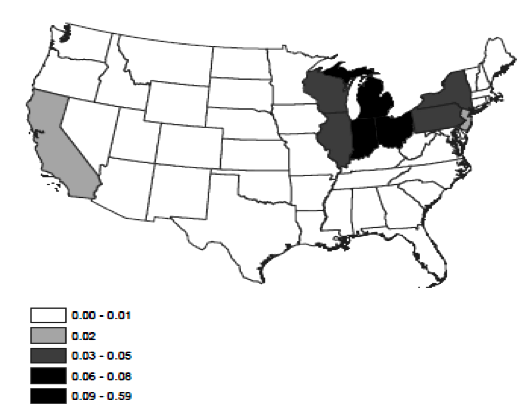Everybody knows that the geography of industrial production changed dramatically during the 20th century both across and within countries. There was clearly a strong spatial aspect to the forces of creative destruction. The ‘left-behind’ victims of these geographic trends are an important constituency in contemporary politics. Yet, relatively little has been written about the evolution of the spatial concentration of manufacturing within countries over time even in the US, for which reasonably good data sources exist.
As economists have come to realise, measurement issues loom large in addressing this topic. Ellison and Glaeser (1997) explained that it is important to control for differences in the size distribution of plants when measuring spatial concentration, and developed an index in which a measure of raw geographic concentration is modified by taking account of the plant Herfindahl index. An important refinement to the basic EG index is to take account of the geographical position of regions through allowing for ‘neighbourhood effects’. This leads to the spatially-weighted version of the EG index proposed by Guimarães et al. (2011).
In a recent paper, we present estimates of the Guimarães et al. index for SIC 3-digit manufacturing industries in the US for selected years between 1880 and 1997 (Crafts and Klein 2017). The main points that come from these estimates are as follows.
- First, there was a big decline over the long run in the average spatial concentration index. This occurred in two phases: gradual prior to 1940, and rapid after 1940. The mean across all industries was 0.223 in 1880, which fell to 0.183 in 1940 and 0.096 in 1997 (Figure 1).1 Greater spatial dispersion was characteristic of the vast majority of manufacturing industries by the second half of the 20th century.
Figure 1 Spatially weighted index
- Second, there was considerable instability in the degree of spatial concentration over time.2 At SIC3 level, the correlation coefficient of the index is 0.17 for 1880 and 1997 and also for 1967 and 1997. Nor was there much persistence in ranking in terms of spatial concentration as is recorded in Table 1.
Table 1 Persistence in spatial concentration at the SIC3 industry level
Note: “Persistently spatially concentrated” means being in the top third of industries in each of 1880, 1940 and 1997, while “persistently spatially dispersed” means being in the bottom third of industries in each of 1880, 1940 and 1997.
Source: derived from Crafts and Klein (2017, Table 5).
- Third, at all times almost all SIC3 industries are spatially concentrated in the sense that the index score is positive and significantly different from zero.3 Indeed, the vast majority of scores throughout the period are above 0.05, the level which Ellison and Glaeser (1997) described as “highly concentrated” and indicative of the existence of significant local cost advantages. This was still true at the end of the period in 1997 when, as noted earlier, the mean was 0.096.
The context for long-run changes in the location of manufacturing has strong similarities with the stylized core-periphery model presented by Krugman and Venables (1995). This would see a move from very high, to intermediate, to very low transport costs driving a move from dispersed to spatially concentrated then back to dispersed locations for manufacturing. In the spatially concentrated (manufacturing belt) phase, the core benefits from economies of scale and proximity to markets and suppliers which raise productivity but also tend to raise wages; subsequently, however, in the context of much lower transport costs, the wage gap becomes too high and moves to the periphery promote a convergence of wage rates.
Glaeser and Kohlhase (2004) pointed out that the costs of moving manufactured goods declined by over 90% in real terms between 1890 and 2000 from 18.5 cents per ton-mile to 2.3 cents (at 2001 prices). In fact, much of this decrease had occurred by 1967 when the cost was only 5.6 cents (at 2001 prices), and by 1891 the railroad revolution had already cut transport costs to about 10% of the 1820s’ level and the manufacturing belt had been born. Average plant size, according to our estimates from the Census of Manufactures, rose from 11.0 in 1880 to 60.6 in 1947, after which it stayed on a plateau until 1977 when it was 62.7, before falling to 46.1 in 1997. We calculate that the ratio of the average wage in manufacturing in East North Central and Mid-Atlantic states relative to East and West South Central states rose from 1.22 in 1890 to 1.52 in 1940, before falling to 1.15 in 1987.
An excellent example of this is Motor Vehicles and Equipment (SIC 371), where overall geographic concentration fell in the second half of the 20th century but where significant localisation persisted in a new configuration. The SMS index for SIC 371 was 0.191 in 1940, 0.120 in 1958, 0.106 in 1977 and 0.094 in 1997. Figures 2a to 2d, which display geographic indices of concentration at the state level, show an evolving pattern of spatial concentration over time such that by 1997, the move away from the 1940 situation of a dominant position for Michigan and an east-west corridor in the southern Great Lakes region has been superseded by one in which Michigan is still a major centre but clusters within ‘Auto Alley’ extend as far south as Alabama (Klier and Rubenstein 2008).
Figure 2 SIC 371 – Motor Vehicles & Motor Vehicle Equipment
a) 1940
b)1958
c) 1977
d) 1997
Two key developments that underlay these changes were the switch of assembly plants in the 1960s away from the coasts to central areas to reduce the costs of transporting cars to customers once these plants became specialised in models for sale throughout the US, and the advent of Japanese producers in the 1980s and 1990s who chose to locate further south – initially Kentucky and Tennessee and then in the deep south. Throughout, parts suppliers wanted to locate close to auto producers. Transport costs were instrumental in some of these decisions, but the move to the south by the Japanese was encouraged by a quest for lower labour costs. Domestic factors drove location decisions through the 1970s before globalization had an impact in the late 20th century.
Clearly, early- and late-20th century industrial geography was very different. Spatial adjustment can be seen as an integral part of the creative destruction, which was instrumental in promoting this change throughout the century. It might be argued that with a relatively flexible economy and mobile society, the US has coped with these pressures rather well. Even so, some workers have been left behind and addressing their grievances has become a big political issue.
References
Crafts, N and A Klein (2017), “A Long-Run Perspective on the Spatial Concentration of Manufacturing Industries in the United States”, CEPR Discussion Paper No. 12257.
Dumais, G, G Ellison and E L Glaeser (2002), “Geographic Concentration as a Dynamic Process”, Review of Economics and Statistics 84: 193-204.
Ellison, G and E L Glaeser (1997), “Geographic Concentration in U.S. Manufacturing Industries: a Dartboard Approach”, Journal of Political Economy 105: 889-927.
Glaeser, E L and J E Kohlhase (2004), “Cities, Regions and the Decline of Transport Costs”, Papers in Regional Science 83: 197-228.
Guimarães, P, O Figueiredo and D Woodward (2011), “Accounting for Neighboring Effects in Measures of Spatial Concentration”, Journal of Regional Science 51: 678-693.
Kim, S (1995), “Expansion of Markets and the Geographic Distribution of Economic Activities: the Trends in U.S. Regional Manufacturing Structure, 1860-1987”, Quarterly Journal of Economics 110: 881-908.
Krugman, P and A J Venables (1995), “Globalization and the Inequality of Nations”, Quarterly Journal of Economics 110: 857-880.
Klier, T and J Rubenstein (2008), Who Really Made Your Car? Kalamazoo: W.E. Upjohn Institute for Employment Research.
Endnotes
[1] This is different from the conventional wisdom of an inverted-U shape in long-run geographic concentration in Kim (1995).
[2] This is different from the findings of Dumais et al. (2002).
[3] In the whole sample, only 20 observations out of over 1300 do not fit this criterion.








